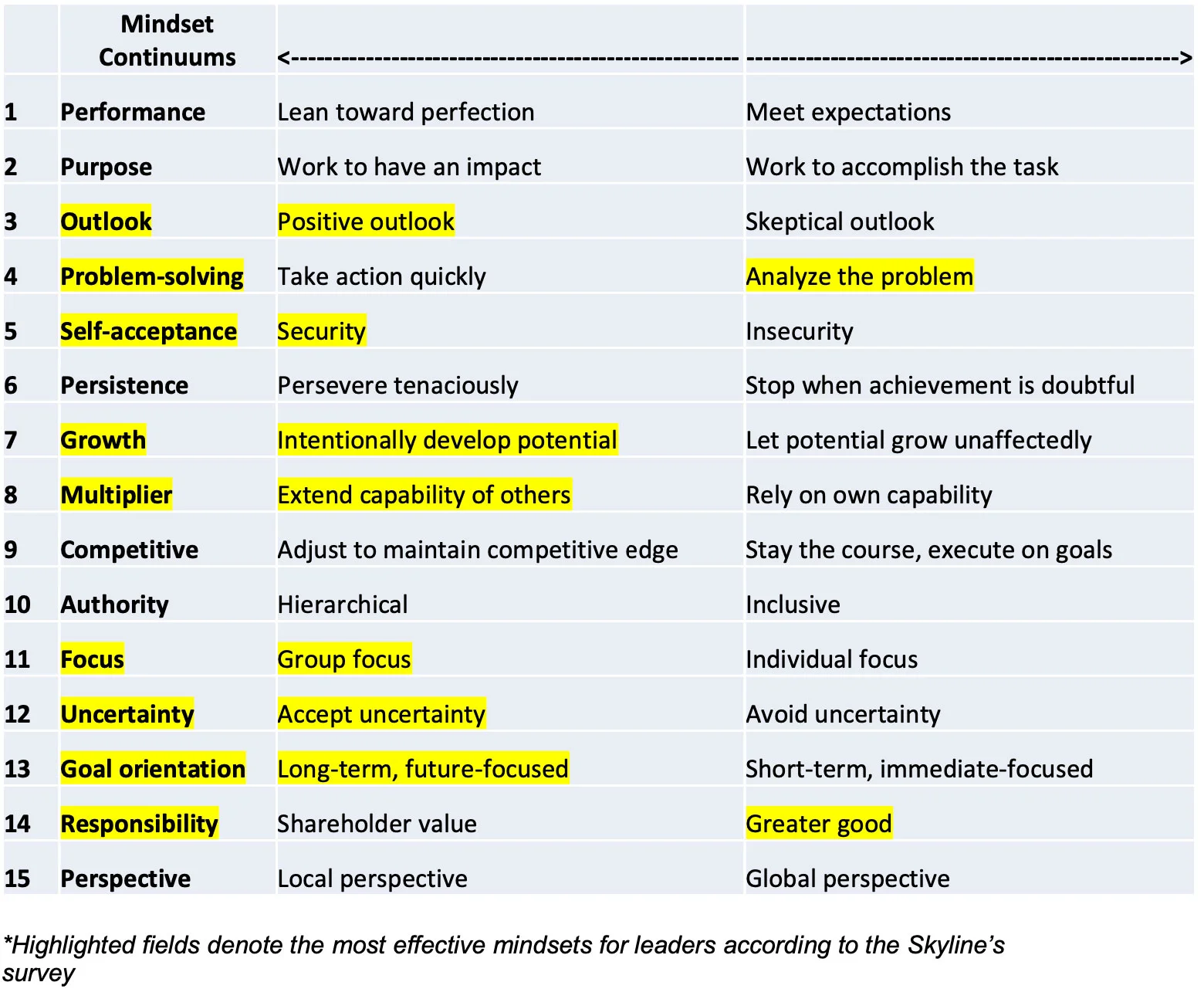Mindset Over Matter: Research and Findings Into Leadership Mindset, Gender Differences Regarding Mindset, and Its Impact on Leadership Performance
Cultivating the Right Leadership Mindset for Success
Anecdotally, people will tell you that to accomplish anything in business or
in life, you have to have the “right mindset.” But what is a mindset exactly?
And how do you know if you have the “right” one—specifically as it relates to
being a leader? In this paper, we explore the range of leadership mindsets,
focusing on the ones that are most linked to effective leadership and how you
can cultivate them.
What is a Mindset?
Your mindset is the way you see and interpret the world. Here’s an over-
simplified example: a person with an optimistic mindset sees a glass as half-
full, whereas someone with a pessimistic mindset sees the glass as half-empty.
Your mindset is a culmination of your background, life experiences and
influences, and natural inclinations—and it is not fixed. Mindset shifts can
occur naturally as you experience new situations or are exposed to new
influences, or they can happen intentionally—if you realize that your mindset
is not serving you, you can actively work to shift it. The key is self-
awareness.
Why the Leader’s Mindset Matters
A leader’s mindset shapes their expectations about their own and their team’s
performance. For example, a leader may believe that with hard work and effort,
their and their team’s skills can be developed or improved. This type of
leader is motivated to put in that hard work and invest in the development of
their team in order to increase performance. They have what is typically known
as a growth mindset.
However, if the leader has a more fixed mindset, they believe that some people
are naturally skilled and some are not and no amount of effort will change
them. This type of leader is less motivated to support the development of
their team because they don’t believe that it will improve their performance.
Not surprisingly, leaders with growth mindsets tend to achieve more because
they actively set goals for themselves that are above their current
capabilities and then put in the work to expand their skill sets. These high
achievers who are continually learning and growing are the ones you want at
the helm of your organization.
The 15 Leadership Mindsets—And Which Ones Matter the Most
As a leader, you can work to nurture and stimulate your own mindset as well as
those of the people on your team to achieve higher levels of performance. The
first step is ensuring you have cultivated the right leadership mindset in
yourself.
In July 2017, Skyline Group’s Organizational Intelligence Institute surveyed
more than 600 male and female leaders to explore how mindset influences both
perception and behaviors.2 We began by identifying the 15 mindset continuums
related to the common roles and attributes of leaders, such as problem-
solving, goal orientation, growth, and focus (see Table 1). Then we surveyed
leaders to determine which mindsets were the most important and where they
believe the most effective leaders fall on each continuum.
Table 1: The 15 Leadership Mindsets

The survey identified nine leadership mindsets that leaders themselves found
crucial to effectiveness:
- A positive outlook (#3)
- Measured problem analysis versus a rush to quick fixes (#4)
- Security in their own strengths and weaknesses (#5)
- A focus on developing others’ potential (#7)
- A recognition of and desire to leverage and extend others’ capabilities (#8)
- A focus on the needs of the group over the individual (#11)
- Acceptance of uncertainty (#12)
- A future orientation (#13)
- A responsibility to the society you live in [the greater good] (#14)
In analyzing the results from the survey, it became clear that the
participants view all effective leaders as:
1. Comfortable with themselves, optimistic about the future, and motivated to
achieve
2. Long-term thinkers who take a holistic and thoughtful approach to problem-
solving
3. Group-focused who treat others with respect and are intent on optimizing
others’ capabilities
However, when the results were separated by gender and generations, we found
some clear differences in leader expectations.
Male versus Female Leaders
According to the survey, women leaders are held to a different, and even
higher and more idealistic standard than their male counterparts. While women
must exhibit the nine leadership mindsets listed above in order to be
perceived as effective, they are also expected to be more balanced and more
inclusive than men:
- Competitive mindset: Men and women rate male leaders more effective when men maintain a competitive edge and are driven to win, while women are seen as more effective when they balance winning at all costs with staying the course to focus on executing the plan.
- Performance mindset: Men and women rate male leaders as more effective when they accept “good enough,” but female leaders as more effective when they balance expecting perfection and accepting “good enough.”
- Authority mindset: Women rate female leaders as more effective when they share and don’t wield their power over people.4 There was no consensus as to how this mindset influenced the effectiveness of male leaders.
There were also significant findings specific to gender and expectations of
effectiveness of female leaders:
- For both the Goal Orientation and Problem-Solving mindsets, women rated female leaders as more effective when they prioritized the long term and took their time to analyze problems compared to male leaders. There was no consensus as to how these mindsets influenced the effectiveness of male leaders specifically.
These survey findings continues to reinforce previous research that women are
harder on women and expect more of female leaders than they do of male
leaders.
Effective Leadership for Millennials
When breaking down our survey participants into generations, we found that
Millennials have very distinct notions of what makes an effective leader. The
millennials surveyed prioritized balance—especially when it came to the
Multiplier and Goal-Setting mindsets.
Millennials want their leaders to be focused on expanding the capabilities of
others and on self- reliance. They also believe their goal orientation should
be equally focused on long-term and short-term solutions.
This is also consistent with the 2016 Skyline Gender Survey where Millennials
were more balanced in their views of leaders of both genders.
Leadership Mindsets in Practice
Study any prominent leader and it will become clear which of the mindsets they
are operating under and how they are driving their success (or failure).
In an article on the ten best leadership moments of 2016, Fast Company writes,
“The smartest leaders are the ones who look out for their employees.” It gives
the example of Hamdi Ulukaya, CEO of Chobani, who created a stock program for
employees in which they are allowed to transfer their shares into stock or
cash in the event of a sale or initial public offering (IPO). With this
decision Ulukaya exhibited the following mindsets:
- A future orientation
- A focus on the needs of the group over the individual
- A responsibility to the society you live in the greater good
Ulukaya acted in the interest of the long-term needs and future financial
wellbeing of his employees at the short-term expense of himself, his executive
team, and others on the top not only because he felt it was the right thing to
do, but because it was a strong, strategic business decision. He invested in
the future success of Chobani by “retaining talent and maintaining internal
satisfaction,” writes Fast Company.
On the opposite end of the leadership spectrum, there is founder and CEO of
Theranos, Elizabeth Holmes, who highlights how the wrong mindset can be a
serious liability to an organization.
Holmes led a startup that sought to disrupt healthcare by offering cheaper and
less invasive blood tests. After an investigative report by The Wall Street
Journal in 2015, doubts surfaced on what their product could actually do.9
Holmes continued to defend Theranos’ testing and methods, and refused to allow
outside scientific scrutiny or peer review. In 2018, the US Securities and
Exchange Commission brought a complaint alleging that company deceived
investors and the public.
The company had told investors that with just one finger-prick of blood, it
could run a multitude of common medical tests and obtain the results within
hours. It was in fact running most of its tests on machines manufactured by
other companies. Holmes falsely told investors that its products were used by
the Department of Defense and that the company would bring in a thousand times
more revenue in 2014 than it actually did, the SEC alleged.
As CEO, the mindsets Holmes seemed to be operating under were:
- An individual focus as opposed to a group focus
- Reacting and taking action too quickly to solve problems without thinking through the consequences
- Short-term focus to gain investor confidence
- Winning at all costs, even if it meant deceit
Holmes’ leadership mindsets clearly contributed to her downfall. Both Holmes
and her company have agreed to settle the cases with a $500,000 penalty.
Holmes was also made to relinquish voting control of the company, return the
shares she obtained during the alleged fraud, and she cannot be part of the
leadership of a public company for a decade.
By avoiding the issues bubbling up within the company and attempting to find
band-aid solutions that did not address the roots of the problems, Holmes’
mindset was her and her company’s downfall. Ultimately, all of her strengths
as an entrepreneur and innovator could not compensate for her poor leadership.
Shifting to the Right Mindset
The mindset of a leader is one of their greatest personal resources and the
key to unlocking it is self-awareness. If you are cognizant of where you fall
in the most important leadership mindset spectrums, then you know how you have
to shift to become more effective.
In “Who develops? Understanding the role of leadership mindset in
developmental opportunities,”11 Walter posits that the three paths to
developing the right leadership mindset are:
1. Seeking feedback
2. Active reflection
3. Conquering the fear of failure
Seeking feedback. Nobody likes unsolicited criticism—at least not when it’s
first given. But if you are someone who actively seeks feedback, you are more
cognitively prepared to receive it—and benefit from it—if and when it comes
your way.
Active reflection. Giving yourself the time and space to reflect on your
actions—and the feedback you receive from your actions—is necessary to
understand what is working for you and what isn’t. It also allows you to think
through what alternate actions and strategies may serve you better next time.
Conquering the fear of failure. A fear of failure limits the potential for
leadership growth, according to Walter, as that fear prevents them from
experimenting. “Someone who fears failure… is more likely to self-handicap
themselves to provide an excuse for failure instead of extending increased
effort toward accomplishing the task.”
How Companies Can Help Leaders
Company culture plays a critical role in getting leaders into the right
mindsets. The organizational environment must be one in which leaders feel
comfortable seeking feedback, actively and openly reflecting on their
performance, and operating with minimum fear of failure.
There are several ways in which organizations can support their leaders in
cultivating the right mindsets. The first is to actively encourage learning
and experimentation by providing resources and development opportunities to
expand their skills and perspectives. Some of the most common and effective
leadership development opportunities include challenging assignments and
coaching.
Another key component of creating a supportive culture is ensuring feedback
loops are embedded into the work flow. This can be done through formal goal
monitoring processes as well as regular 360-feedback assessments.
The last way leaders can feel empowered to make the appropriate shifts is to
ensure that the top levels of the organization are modeling the right mindsets
and acting accordingly, that is, by seeking feedback, sharing their
reflections on their own performance, and bouncing back from failure.
Conclusion
Your mindset is the way you see and interpret the world. It is a culmination
of your background, life experiences and influences, and natural inclinations
—and it is not fixed. Mindset shifts can occur naturally as you experience
new situations or are exposed to new influences, or they can happen
intentionally—if you realize that your mindset if not serving you, you can
actively work to shift it.
As a leader, you can work to nurture and stimulate the mindsets of the people
on your team to achieve higher levels of performance. The first step is
ensuring you have cultivated the right leadership mindset in yourself. To that
end, Skyline Group’s Organizational Intelligence Institute has identified the
nine leadership mindsets that leaders find crucial to effectiveness:
- Measured problem analysis versus a rush to quick fixes
- Security in their own strengths and weaknesses
- A focus on developing others’ potential
- A recognition of and desire to leverage and extend others’ capabilities
- A focus on the needs of the group over the individual
- Acceptance of uncertainty
- A future orientation
- A responsibility to the society you live in the greater good
It is important to note, however, that there are some gender and generational
differences in perceived leadership effectiveness. For example, millennials
tend to prioritize balance in their leaders (as opposed to leaning to any one
side of the mindset continuums). In addition, male leaders may have more
leeway in exhibiting mindsets that are on the “wrong” side of a mindset
continuum while still being seen as effective.
Study any prominent leader and it will become clear which of these mindsets
they are operating under (or not) and how it is driving their success (or
failure). To increase your effectiveness as a leader, it is important to study
yourself with the same rigor. If you are cognizant of where you fall in the
most important leadership mindset spectrums, then you know how what shifts you
need to become more effective.
According to Walter, the three paths to developing the right leadership
mindset are:
1. Seeking feedback—so you are emotionally prepared to receive and act on it
2. Active reflection—to understand what is and isn’t working for you
3. Conquering the fear of failure—so you feel free to experiment with new,
possibly more effective ways of thinking and being
All three of these paths are dependent on an intimate awareness of yourself as
a leader and an honest acknowledgement of your strengths and weaknesses.
From an organizational perspective, there are several ways in which businesses
can support their leaders in cultivating the right mindsets. The first is to
actively encourage learning and experimentation, for example, through
challenging assignments and coaching. Companies must also ensure feedback
loops are embedded into the work flow, for example, through formal goal
monitoring processes as well as regular 360-feedback assessments. And perhaps
most importantly, the top levels of the organization must model the right
mindsets by seeking feedback and sharing their reflections on their own
performance and bouncing back from failure.
Reference:
1. Fixed Mindset vs. Growth Mindset (What Characteristics Are Critical to
Success). (2017, October 25). Retrieved April 24, 2018, from
https://www.developgoodhabits.com/fixed-mindset-vs-growth-mindset/
2 Skyline Group (2017). Leadership Mindset Study.
3 Skyline Group (2016). Genderless Leader Study.
4 Women and Leadership. (2015, January 14). Retrieved May 7, 2018, from
https://www.pewsocialtrends.org/2015/01/14/women-and-leadership/
5 Duguid, M. (2011). Female tokens in high-prestige work groups: Catalysts or
inhibitors of group diversification? Organizational Behavior and Human
Decision Processes, 116(1).
6 Namie, G., Christensen, D., & Phillips, D. (2014, February). 2014 WBI U.S.
Workplace Bullying Survey. Retrieved May 7, 2018, from https://www.workplacebullying.org/wbiresearch/wbi-2014-us-survey/
7 Skyline Group (2016). Genderless Leader Study.
8 Dishman, L. (2016, December 28). The 10 Best And Worst Moments In Leadership
2016. Retrieved April 24, 2018, from https://www.fastcompany.com/3066206/the-10-best-and-worst-moments-in-leadership-2016
9 Carreyrou, J. (2015, October 16). Hot Startup Theranos Has Struggled With
Its Blood-Test Technology. Retrieved May 7, 2018, from https://www.wsj.com/articles/theranos-has-struggled-with-blood-tests-1444881901
10 Robbins, R. (2018, March 15). SEC charges Theranos and CEO Elizabeth Holmes
with fraud. Retrieved May 7, 2018, from https://www.statnews.com/2018/03/14/sec-charges-theranos-elizabeth-holmes/
11 Walter, Sheryl L. “Who develops? Understanding the role of leadership
mindset in developmental opportunities.” PhD (Doctor of Philosophy) thesis,
University of Iowa, 2016. https://ir.uiowa.edu/etd/2162
12 Walter, Sheryl L. “Who develops? Understanding the role of leadership
mindset in developmental opportunities.” PhD (Doctor of Philosophy) thesis,
University of Iowa, 2016. https://ir.uiowa.edu/etd/2162






